

Norse cosmology. World. Norse 9 realms. Niflheim. Niflheim was primarily a realm of primordial ice and cold, with nine frozen rivers.
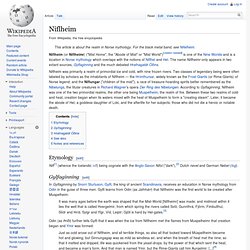
Jötunheimr. Giant Skrymir and Thor Louis Huard Jötunheimr (or Jǫtunheimr; often anglicized as Jotunheim) is one of the Nine Worlds and the homeland (heim 'home') of the Giants of Norse Mythology — Rock Giants and Frost Giants.
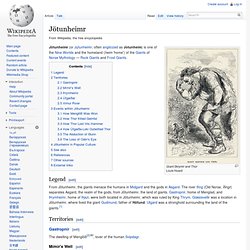
Legend[edit] From Jötunheimr, the giants menace the humans in Midgard and the gods in Asgard. The river Ifing (Old Norse, Ífingr) separates Asgard, the realm of the gods, from Jötunheimr, the land of giants. Gastropnir, home of Menglad, and Þrymheimr, home of Þjazi, were both located in Jötunheimr, which was ruled by King Thrym. Territories[edit] Gastropnir[edit] Asgard. In Norse religion, Asgard (Old Norse: ''Ásgarðr''; "Enclosure of the Æsir"[1]) is one of the Nine Worlds and home to the Æsir tribe of gods.
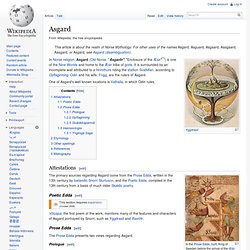
It is surrounded by an incomplete wall attributed to a Hrimthurs riding the stallion Svaðilfari, according to Gylfaginning. Odin and his wife, Frigg, are the rulers of Asgard. One of Asgard's well known locations is Valhalla, in which Odin rules. Attestations[edit] Álfheimr. Alfheim (Old Norse: Ālfheimr, "elf home") is one of the Nine Worlds and home of the Light Elves in Norse mythology.
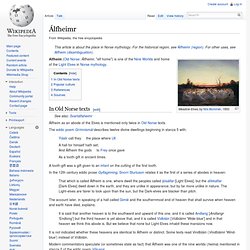
In Old Norse texts[edit] Álfheim as an abode of the Elves is mentioned only twice in Old Norse texts. The eddic poem Grímnismál describes twelve divine dwellings beginning in stanza 5 with: Ýdalir call they the place where UllA hall for himself hath set; And Álfheim the gods to Frey once gave As a tooth-gift in ancient times. A tooth-gift was a gift given to an infant on the cutting of the first tooth. Midgard. Midgard (an anglicised form of Old Norse Miðgarðr; Old English Middangeard, Swedish Midgård, Old Saxon Middilgard, Old High German Mittilagart, Gothic Midjun-gards; literally "middle enclosure") is the name for the world (in the sense of oikoumene) inhabited by and known to humans in early Germanic cosmology, and specifically one of the Nine Worlds in Norse mythology.
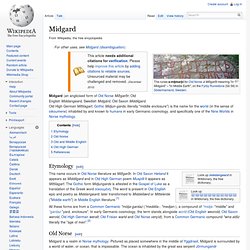
Etymology[edit] All these forms are from a Common Germanic *midja-gardaz (*meddila-, *medjan-), a compound of *midja- "middle" and *gardaz "yard, enclosure". In early Germanic cosmology, the term stands alongside world (Old English weorold, Old Saxon werold, Old High German weralt, Old Frisian warld and Old Norse verǫld), from a Common Germanic compound *wira-alđiz literally the "age of men".[2]
Bifröst. Yggdrasil. In Norse mythology, Yggdrasil (/ˈɪɡdrəsɪl/; from Old Norse Yggdrasill, pronounced [ˈyɡːˌdrasilː]) is an immense tree that is central in Norse cosmology, in connection to which the nine worlds exist.
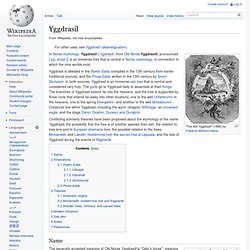
Conflicting scholarly theories have been proposed about the etymology of the name Yggdrasill, the possibility that the tree is of another species than ash, the relation to tree lore and to Eurasian shamanic lore, the possible relation to the trees Mímameiðr and Læraðr, Hoddmímis holt, the sacred tree at Uppsala, and the fate of Yggdrasil during the events of Ragnarök. Name The generally accepted meaning of Old Norse Yggdrasill is "Odin's horse", meaning "gallows". This interpretation comes about because drasill means "horse" and Ygg(r) is one of Odin's many names. The Poetic Edda poem Hávamál describes how Odin sacrificed himself by hanging from a tree, making this tree Odin's gallows. A third interpretation, presented by F.
Attestations Poetic Edda Völuspá. Svartálfar and Svartálfaheimr. In Norse mythology, svartálfar (Old Norse "swart elves" or "black elves", singular svartálfr) are beings who dwell in Svartálfaheimr (anglicized as Svartalfheim, "world of black-elves").[1] Both the svartálfar and Svartálfaheimr are solely attested in the Prose Edda, written in the 13th century by Snorri Sturluson.
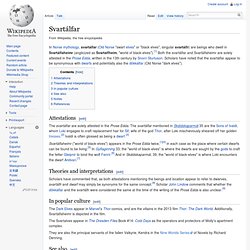
Scholars have noted that the svartálfar appear to be synonymous with dwarfs and potentially also the dökkálfar (Old Norse "dark elves"). Attestations[edit] Svartálfaheimr ("world of black-elves") appears in the Prose Edda twice,[1][4] in each case as the place where certain dwarfs can be found to be living:[5] In Gylfaginning 33, the "world of black-elves" is where the dwarfs are sought by the gods to craft the fetter Gleipnir to bind the wolf Fenrir.[6] And in Skáldskaparmál, 39, the "world of black-elves" is where Loki encounters the dwarf Andvari.[7] Theories and interpretations[edit] In popular culture[edit] See also[edit] Dökkálfar and Ljósálfar Notes[edit] Múspellsheimr. According to the Ragnarök prophecies in Snorri Sturluson's Gylfaginning, the first part of his Prose Edda, the sons of Muspell will break the Bifröst bridge, signaling the end of times: In the midst of this clash and din the heavens are rent in twain, and the sons of Muspell come riding through the opening.

Surtr rides first, and before him and after him flames burning fire. He has a very good sword, which shines brighter than the sun. As they ride over Bifrost it breaks to pieces, as has before been stated. Niðavellir. In Norse mythology, Niðavellir (anglicized as Nidavellir, Dark Court or Dark Dwelling) is the home of Dwarves.
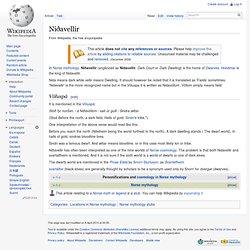
Hreidmar is the king of Nidavellir. Nida means dark while vellir means Dwelling. It should however be noted that it is translated as 'Fields' sometimes. 'Nidavallir' is the more recognized name but in the Völuspa it is written as Nidavöllum. Völlom simply means field. Vanaheimr. Ginnungagap. In Norse Myth, Ginnungagap ("mighty gap") is the vast, primordial void that existed prior to the creation of the manifest universe.
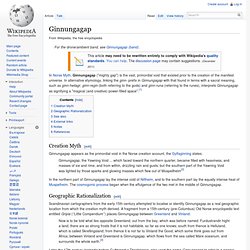
In alternative etymology, linking the ginn- prefix in Ginnungagap with that found in terms with a sacral meaning, such as ginn-heilagr, ginn-regin (both referring to the gods) and ginn-runa (referring to the runes), interprets Ginnungagap as signifying a "magical (and creative) power-filled space".[1] Creation Myth[edit]